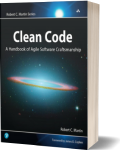Clean Code: A Handbook of Agile Software Craftsmanship
Software Development
Book Details
Book Title
Clean Code: A Handbook of Agile Software Craftsmanship
Author
Robert C. Martin(Uncle Bob)
Publisher
Pearson
Publication Date
2008
ISBN
9780136083238
Number of Pages
462
Language
English
Format
File Size
2.8MB
Subject
clean code
Table of Contents
- Clean Code
- Contents
- Foreword
- Introduction
- On the Cover
- Chapter 1: Clean Code
- There Will Be Code
- Bad Code
- The Total Cost of Owning a Mess
- Schools of Thought
- We Are Authors
- The Boy Scout Rule
- Prequel and Principles
- Conclusion
- Bibliography
- Chapter 2: Meaningful Names
- Introduction
- Use Intention-Revealing Names
- Avoid Disinformation
- Make Meaningful Distinctions
- Use Pronounceable Names
- Use Searchable Names
- Avoid Encodings
- Avoid Mental Mapping
- Class Names
- Method Names
- Don't Be Cute
- Pick One Word per Concept
- Don't Pun
- Use Solution Domain Names
- Use Problem Domain Names
- Add Meaningful Context
- Don't Add Gratuitous Context
- Final Words
- Chapter 3: Functions
- Small!
- Do One Thing
- One Level of Abstraction per Function
- Switch Statements
- Use Descriptive Names
- Function Arguments
- Have No Side Effects
- Command Query Separation
- Prefer Exceptions to Returning Error Codes
- Don't Repeat Yourself
- Structured Programming
- How Do You Write Functions Like This?
- Conclusion
- SetupTeardownIncluder
- Bibliography
- Chapter 4: Comments
- Comments Do Not Make Up for Bad Code
- Explain Yourself in Code
- Good Comments
- Bad Comments
- Bibliography
- Chapter 5: Formatting
- The Purpose of Formatting
- Vertical Formatting
- Horizontal Formatting
- Team Rules
- Uncle Bob's Formatting Rules
- Chapter 6: Objects and Data Structures
- Data Abstraction
- Data/Object Anti-Symmetry
- The Law of Demeter
- Data Transfer Objects
- Conclusion
- Bibliography
- Chapter 7: Error Handling
- Use Exceptions Rather Than Return Codes
- Write Your Try-Catch-Finally Statement First
- Use Unchecked Exceptions
- Provide Context with Exceptions
- Define Exception Classes in Terms of a Caller's Needs
- Define the Normal Flow
- Don't Return Null
- Don't Pass Null
- Conclusion
- Bibliography
- Chapter 8: Boundaries
- Using Third-Party Code
- Exploring and Learning Boundaries
- Learning log4j
- Learning Tests Are Better Than Free
- Using Code That Does Not Yet Exist
- Clean Boundaries
- Bibliography
- Chapter 9: Unit Tests
- The Three Laws of TDD
- Keeping Tests Clean
- Clean Tests
- One Assert per Test
- F.I.R.S.T.
- Conclusion
- Bibliography
- Chapter 10: Classes
- Class Organization
- Classes Should Be Small!
- Organizing for Change
- Bibliography
- Chapter 11: Systems
- How Would You Build a City?
- Separate Constructing a System from Using It
- Scaling Up
- Java Proxies
- Pure Java AOP Frameworks
- AspectJ Aspects
- Test Drive the System Architecture
- Optimize Decision Making
- Use Standards Wisely, When They Add Demonstrable Value
- Systems Need Domain-Specific Languages
- Conclusion
- Bibliography
- Chapter 12: Emergence
- Getting Clean via Emergent Design
- Simple Design Rule 1: Runs All the Tests
- Simple Design Rules 2–4: Refactoring
- No Duplication
- Expressive
- Minimal Classes and Methods
- Conclusion
- Bibliography
- Chapter 13: Concurrency
- Why Concurrency?
- Challenges
- Concurrency Defense Principles
- Know Your Library
- Know Your Execution Models
- Beware Dependencies Between Synchronized Methods
- Keep Synchronized Sections Small
- Writing Correct Shut-Down Code Is Hard
- Testing Threaded Code
- Conclusion
- Bibliography
- Chapter 14: Successive Refinement
- Args Implementation
- Args: The Rough Draft
- String Arguments
- Conclusion
- Chapter 15: JUnit Internals
- The JUnit Framework
- Conclusion
- Chapter 16: Refactoring SerialDate
- First, Make It Work
- Then Make It Right
- Conclusion
- Bibliography
- Chapter 17: Smells and Heuristics
- Comments
- Environment
- Functions
- General
- Java
- Names
- Tests
- Conclusion
- Bibliography
- Appendix A: Concurrency II
- Appendix B: org.jfree.date.SerialDate
- Appendix C: Cross References of Heuristics
- Epilogue
- Index
